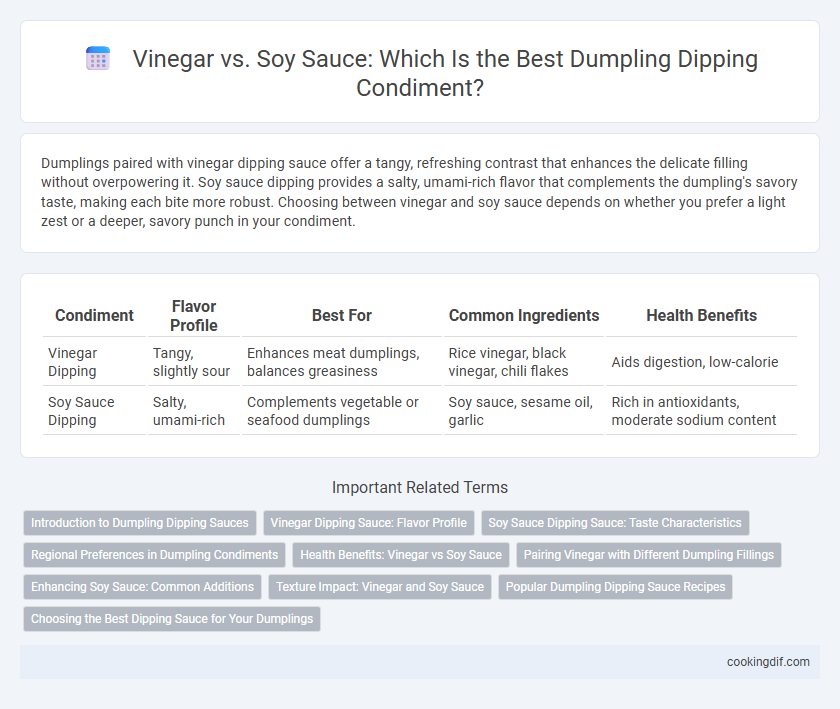Dumplings paired with vinegar dipping sauce offer a tangy, refreshing contrast that enhances the delicate filling without overpowering it. Soy sauce dipping provides a salty, umami-rich flavor that complements the dumpling's savory taste, making each bite more robust. Choosing between vinegar and soy sauce depends on whether you prefer a light zest or a deeper, savory punch in your condiment.
Table of Comparison
| Condiment | Flavor Profile | Best For | Common Ingredients | Health Benefits |
|---|---|---|---|---|
| Vinegar Dipping | Tangy, slightly sour | Enhances meat dumplings, balances greasiness | Rice vinegar, black vinegar, chili flakes | Aids digestion, low-calorie |
| Soy Sauce Dipping | Salty, umami-rich | Complements vegetable or seafood dumplings | Soy sauce, sesame oil, garlic | Rich in antioxidants, moderate sodium content |
Introduction to Dumpling Dipping Sauces
Dumpling dipping sauces vary widely, with vinegar and soy sauce as two of the most popular bases, each enhancing the dumpling's flavor profile differently. Vinegar dipping sauces, often made from black or rice vinegar, provide a tangy and slightly sweet contrast that complements rich, savory fillings. Soy sauce-based dips offer a salty, umami depth, sometimes combined with garlic, chili, or sesame oil for added complexity, making both sauces essential in diverse culinary traditions.
Vinegar Dipping Sauce: Flavor Profile
Vinegar dipping sauce for dumplings offers a tangy and refreshing flavor profile that enhances the natural savory taste of the filling without overpowering it. The acidity of the vinegar cuts through the richness, providing a balanced contrast that brightens each bite and elevates the overall eating experience. This condiment is especially popular in Chinese cuisine, where black vinegar or rice vinegar is commonly used to add depth and a subtle sweetness to the dipping sauce.
Soy Sauce Dipping Sauce: Taste Characteristics
Soy sauce dipping sauce for dumplings offers a rich umami flavor with a balance of salty and slightly sweet notes that enhance the natural taste of the filling. Its smooth, savory profile complements both meat and vegetable dumplings, making each bite more flavorful and satisfying. The dark, aromatic soy sauce also adds a subtle depth of flavor that pairs well with garlic, ginger, or chili-infused variations for added complexity.
Regional Preferences in Dumpling Condiments
Vinegar dipping sauces are predominantly favored in Northern China, particularly in regions like Beijing and Shandong, where the tangy acidity complements the rich, savory flavors of pork-filled dumplings. Southern Chinese areas, such as Guangdong and Fujian, lean towards soy sauce-based dips often combined with chili oil and garlic to enhance the umami and spice profile. These regional preferences highlight how local culinary traditions influence the choice of condiments, shaping the overall dumpling experience with either sharp vinegar notes or deep, salty soy sauce savoriness.
Health Benefits: Vinegar vs Soy Sauce
Vinegar dipping for dumplings offers significant health benefits due to its low calorie content and rich acetic acid, which may aid digestion and help regulate blood sugar levels. Soy sauce, while flavorful, contains high sodium levels that can contribute to increased blood pressure if consumed excessively. Choosing vinegar over soy sauce as a condiment supports heart health and promotes better digestive wellness.
Pairing Vinegar with Different Dumpling Fillings
Vinegar dipping sauce enhances the flavor of dumplings with rich, fatty fillings such as pork or beef by cutting through the heaviness and adding a tangy contrast. For vegetable-filled dumplings, light black vinegar complements the fresh, subtle flavors without overpowering them. Combining vinegar with a touch of chili oil or garlic also intensifies the overall taste, making it a versatile condiment choice.
Enhancing Soy Sauce: Common Additions
Enhancing soy sauce for dumpling dipping often involves adding ingredients like rice vinegar, chili oil, sesame oil, garlic, or ginger to create a balanced and flavorful condiment. Vinegar dipping typically emphasizes acidity to cut through greasy textures, while soy sauce-based dips deliver umami and depth with customized additions that heighten the overall taste profile. Combining soy sauce with these common additives transforms a simple dip into a complex, aromatic complement that elevates dumpling enjoyment.
Texture Impact: Vinegar and Soy Sauce
Vinegar dipping imparts a sharp, tangy contrast that enhances the dumpling's delicate, chewy texture by cutting through its richness and preventing palate fatigue. Soy sauce dipping contributes a savory, umami depth that complements the dumpling's soft exterior while adding a slight slickness, which can make the texture feel silkier and more cohesive. The choice between vinegar and soy sauce as a condiment significantly alters the bite experience, balancing acidity and saltiness to elevate the overall mouthfeel of the dumpling.
Popular Dumpling Dipping Sauce Recipes
Vinegar dipping sauce, often made with black rice vinegar and sometimes infused with chili or garlic, enhances dumplings with a tangy and slightly acidic flavor that cuts through rich fillings. Soy sauce dipping, typically combined with sesame oil and green onions, offers a salty and umami-rich complement that intensifies the taste of meat or vegetable dumplings. Popular dumpling dipping sauce recipes balance these ingredients to create a harmonious blend, catering to diverse palates and regional preferences.
Choosing the Best Dipping Sauce for Your Dumplings
Choosing the best dipping sauce for your dumplings depends on flavor preferences and the type of dumpling. Vinegar dipping sauce, often made with black or rice vinegar, adds a tangy and slightly acidic taste that cuts through rich fillings like pork or pork and cabbage, enhancing the overall experience. Soy sauce dipping provides a salty, umami flavor that pairs well with vegetable or chicken dumplings, balancing the lightness of the ingredients.
Vinegar dipping vs Soy sauce dipping for condiment Infographic

 cookingdif.com
cookingdif.com